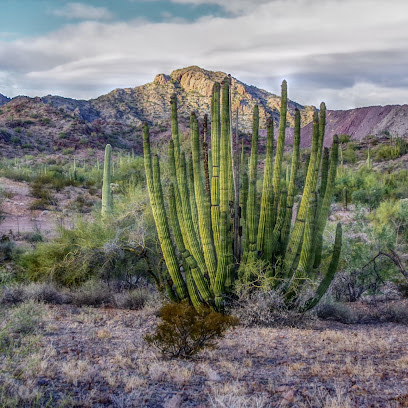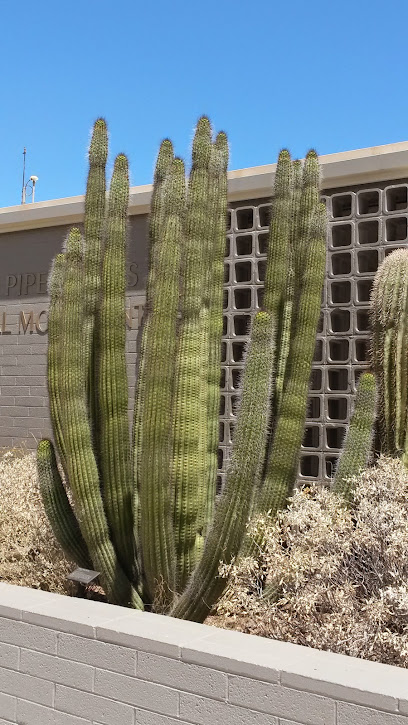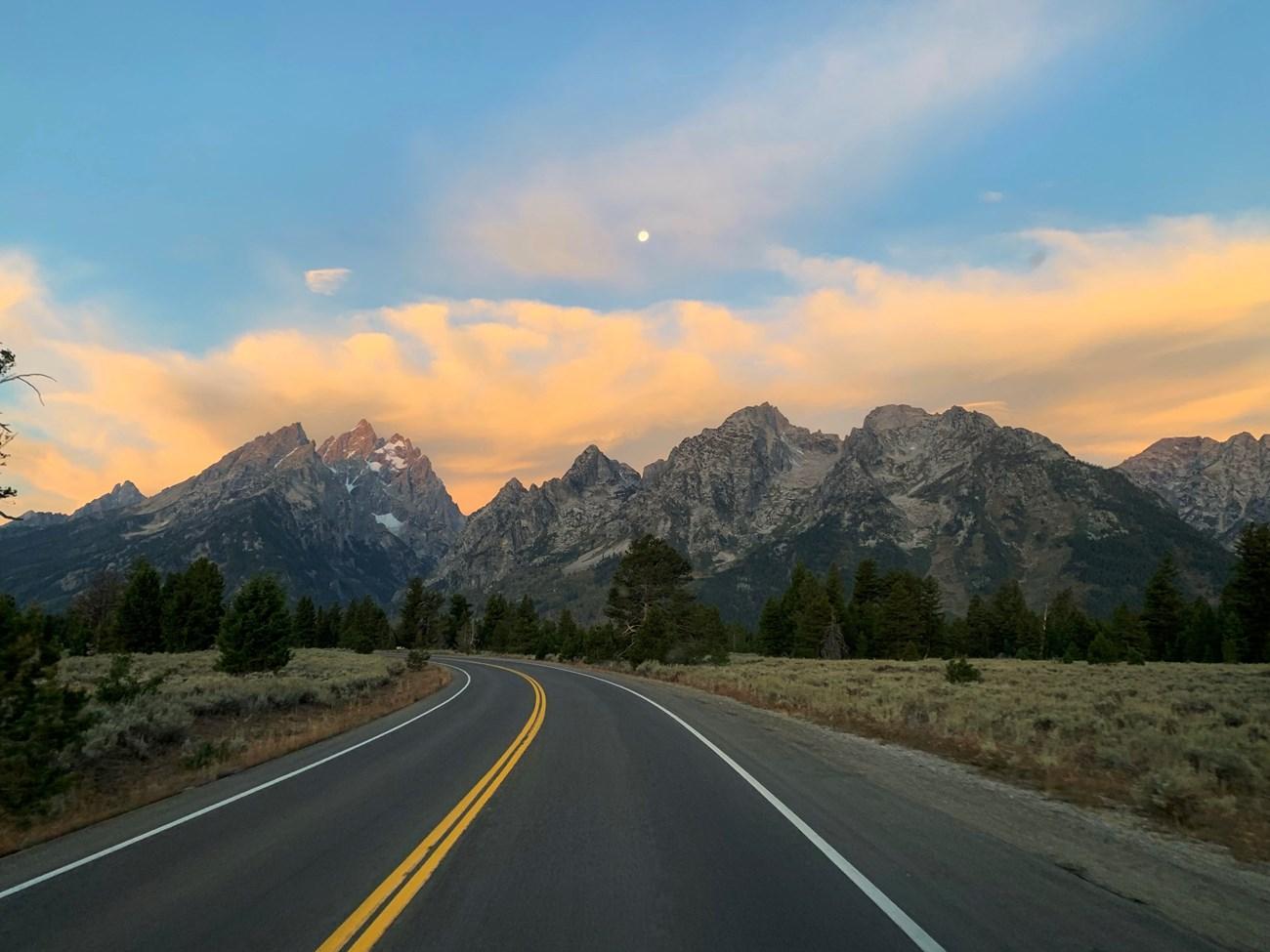
Organ Pipe Cactus National Monument: A Desert Oasis
Discover the serene beauty and unique flora of Organ Pipe Cactus National Monument, a hidden gem in the Sonoran Desert perfect for nature enthusiasts and adventurers.
Nestled in the heart of the Sonoran Desert, Organ Pipe Cactus National Monument is a unique and serene destination for nature lovers and adventure seekers alike. This protected area is home to the stunning organ pipe cactus, a rare species that only grows in this region. The monument spans over 330,000 acres and offers a diverse landscape of rugged mountains, sweeping valleys, and vast desert plains. Visitors to Organ Pipe Cactus National Monument can explore a variety of hiking trails that range from easy walks to challenging treks. The Ajo Mountain Drive is a popular scenic route that provides breathtaking views of the desert landscape and its unique flora and fauna. The Kris Eggle Visitor Center is a great starting point for your adventure, offering informative exhibits and helpful rangers who can provide maps and advice on the best trails and activities. Wildlife enthusiasts will be delighted by the diverse animal species that inhabit the park, including desert bighorn sheep, javelinas, and a variety of bird species. The monument is also an excellent spot for stargazing, thanks to its remote location and minimal light pollution. Whether you're interested in hiking, photography, or simply soaking in the natural beauty, Organ Pipe Cactus National Monument offers a peaceful escape into the heart of the desert.
Local tips in Organ Pipe Cactus National Monument
- Visit during the cooler months (November to March) for more comfortable hiking conditions.
- Bring plenty of water, sunscreen, and a hat to protect yourself from the desert sun.
- Check road conditions before visiting, as some roads may be closed due to weather or maintenance.
- Stop by the Kris Eggle Visitor Center for maps, trail information, and to learn about the park's history.
- Consider camping at the Twin Peaks Campground for an immersive desert experience and excellent stargazing opportunities.
Organ Pipe Cactus National Monument: A Desert Oasis
Nestled in the heart of the Sonoran Desert, Organ Pipe Cactus National Monument is a unique and serene destination for nature lovers and adventure seekers alike. This protected area is home to the stunning organ pipe cactus, a rare species that only grows in this region. The monument spans over 330,000 acres and offers a diverse landscape of rugged mountains, sweeping valleys, and vast desert plains. Visitors to Organ Pipe Cactus National Monument can explore a variety of hiking trails that range from easy walks to challenging treks. The Ajo Mountain Drive is a popular scenic route that provides breathtaking views of the desert landscape and its unique flora and fauna. The Kris Eggle Visitor Center is a great starting point for your adventure, offering informative exhibits and helpful rangers who can provide maps and advice on the best trails and activities. Wildlife enthusiasts will be delighted by the diverse animal species that inhabit the park, including desert bighorn sheep, javelinas, and a variety of bird species. The monument is also an excellent spot for stargazing, thanks to its remote location and minimal light pollution. Whether you're interested in hiking, photography, or simply soaking in the natural beauty, Organ Pipe Cactus National Monument offers a peaceful escape into the heart of the desert.
When is the best time to go to Organ Pipe Cactus National Monument?
Unmissable attractions to see
Sonoran Desert National Monument
Discover the stunning landscapes, diverse wildlife, and rich history of the Sonoran Desert National Monument in Arizona.

Tumacacori National Historical Park
Discover the historical treasures of Tumacacori National Historical Park, a serene blend of culture and nature in southern Arizona.

Kris Eggle Visitor Center
Explore the breathtaking landscapes of Organ Pipe Cactus National Monument at the Kris Eggle Visitor Center - your gateway to adventure in the Sonoran Desert.

Twin Peaks Campground
Explore the breathtaking landscapes and serene atmosphere at Twin Peaks Campground in Arizona, a perfect retreat for nature lovers and camping enthusiasts.

Cabeza Prieta National Wildlife Refuge Administration Office and Visitor Center
Explore the majestic beauty and diverse wildlife of Cabeza Prieta National Wildlife Refuge, a hidden gem in Arizona's desert landscape.

Estes Canyon - Bull Pasture Trail Head
Discover the awe-inspiring landscapes and unique geological formations at Estes Canyon - Bull Pasture Trail Head, a must-visit hiking destination in Arizona.

Victoria Mine Trail Head
Discover the natural beauty and historical significance of Victoria Mine Trail Head, a hiking gem in Ajo, Arizona, offering breathtaking desert vistas.

Dos Lomitas Ranch
Explore the rich history of ranching at Dos Lomitas Ranch, a captivating historical landmark in beautiful Lukeville, Arizona.

Gachado Line Camp
Discover the Gachado Line Camp in Lukeville, Arizona, a historical landmark that narrates the untold stories of the past amidst stunning desert scenery.

Essential places to dine
Organ Pipe Cactus National Monument
Explore Organ Pipe Cactus National Monument - A Natural Wonderland in Arizona with Stunning Landscapes and Rich Cultural Heritage.

LongHorn Steakhouse
Indulge in mouthwatering steaks and traditional American cuisine at LongHorn Steakhouse in Paradise Valley – where flavor meets comfort.

Oregano's
Discover authentic Italian flavors at Oregano's in Phoenix – where every pizza tells a story!

Kris Eggle Visitor Center
Explore nature at its finest at Kris Eggle Visitor Center in Organ Pipe Cactus National Monument – a hub for adventure and education.

Markets, malls and hidden boutiques
Organ Pipe Cactus National Monument
Explore the breathtaking Organ Pipe Cactus National Monument, a unique desert paradise filled with stunning landscapes and diverse wildlife.

Kris Eggle Visitor Center
Unveil the secrets of the Arizona desert at Kris Eggle Visitor Center, your gateway to Organ Pipe Cactus National Monument's stunning beauty.

Bashas'
Discover convenience and local flavors at Bashas' Grocery Store in Sells, Arizona – your go-to stop for essentials and regional delights.

Olsens Marketplace ACE Hardware
Discover Olsens Marketplace ACE Hardware in Ajo, Arizona – your go-to for all home improvement needs, tools, and friendly expert advice.

Gu-Achi Trading Post
Explore the vibrant Gu-Achi Trading Post, a cultural gem in Sells, Arizona, offering unique crafts, souvenirs, and local essential goods.

Dollar General
Explore Dollar General in Ajo, Arizona for unbeatable deals on everyday essentials, beauty supplies, and delightful finds for every traveler.

Olsens Marketplace IGA
Explore Olsens Marketplace IGA in Ajo, Arizona, for fresh local produce, meats, and a welcoming shopping experience during your travels.

Why Not Travel Store
Discover convenience at Why Not Travel Store in Ajo, Arizona – offering everything from snacks to auto insurance for your travel needs.

Alamo Canyon Primitive Campground
Experience the tranquility of Alamo Canyon Primitive Campground, a perfect getaway for nature lovers in the stunning Ajo region of Arizona.

Shell
Discover the convenience of Shell gas station in Ajo, AZ, where fueling up meets friendly service and essential travel supplies.

The Museum Store | Phoenix Art Museum
Explore unique gifts and art-inspired souvenirs at The Museum Store in Phoenix Art Museum, a must-visit for art lovers and tourists.

UETA Duty Free
Discover unbeatable tax-free shopping at UETA Duty Free in Lukeville, Arizona, with a vast selection of luxury goods and souvenirs.

Ajo Copper News
Discover Ajo Copper News in Arizona: a unique blend of journalism and art showcasing local talent and stories.

Circle K
Discover convenience at Circle K in Ajo, Arizona, your essential stop for snacks, drinks, and ATM services on your desert adventure.

The Store
Discover local flavors and essential goods at The Store, a grocery gem in the Tohono O'odham Nation.

Essential bars & hidden hideouts
Lookout Tavern
Discover Lookout Tavern in Phoenix, AZ – a dynamic bar and restaurant offering great food, drinks, and sports in a vibrant setting.

Bitter & Twisted Cocktail Parlour
Discover the vibrant atmosphere and innovative cocktails at Bitter & Twisted Cocktail Parlour in Downtown Phoenix, a must-visit for nightlife enthusiasts.

The White Rabbit
Experience the unique blend of cocktail culture and nightlife at The White Rabbit in Gilbert, Arizona, where every night is a celebration.

12 West Brewing - Downtown Mesa
Discover the perfect blend of craft beers and gourmet dining at 12 West Brewing in Downtown Mesa, a culinary gem for all beer lovers.

The Whining Pig Gilbert
Experience the vibrant atmosphere of The Whining Pig in Gilbert, where craft beers, fine wines, and delicious pub fare meet entertainment.

Cactus Jack's Bar & Grill
Experience the vibrant atmosphere and delicious flavors at Cactus Jack's Bar & Grill, a top destination for food and sports lovers in Phoenix.

Raven's View
Discover the exquisite wines and delightful cuisine at Raven's View, nestled in the breathtaking landscapes of Cave Creek, Arizona.

The Whining Pig Desert Ridge
Discover delightful wines and local brews at The Whining Pig Desert Ridge, the perfect bar for relaxation and socializing in Phoenix.

Cactus Tavern
Discover the vibrant atmosphere of Cactus Tavern, where delicious American cuisine meets a lively bar experience in Phoenix, AZ.

Killer Whale Sex Club
Explore the vibrant nightlife of Downtown Phoenix at Killer Whale Sex Club, where unique cocktails and electric ambiance await.

The Bar
Explore The Bar in Phoenix – where innovative cocktails, live music, and a vibrant atmosphere come together for an unforgettable night out.

Dave's On Northern
Discover the lively atmosphere and affordable drinks at Dave's On Northern, a top bar in Phoenix's North Mountain Village.

Kris Eggle Visitor Center
Discover the beauty of the Sonoran Desert at Kris Eggle Visitor Center, your gateway to Organ Pipe Cactus National Monument.

Taqueria El Bueno
Indulge in the authentic taste of Mexico at Taqueria El Bueno, where every taco is a celebration of flavor and tradition.

Twin Peaks Campground
Explore the natural beauty of Twin Peaks Campground in Arizona, where unique desert landscapes meet modern camping amenities for an unforgettable experience.

Local Phrases about Organ Pipe Cactus National Monument
-
- HelloHola
[oh-lah] - GoodbyeAdiós
[ah-dee-ohs] - YesSí
[see] - NoNo
[noh] - Please/You're welcomePor favor/De nada
[por fah-vor/deh nah-dah] - Thank youGracias
[grah-see-ahs] - Excuse me/SorryPerdón/Lo siento
[pair-dohn/loh see-en-toh] - How are you?¿Cómo estás?
[koh-moh ehs-tahs] - Fine. And you?Bien. ¿Y tú?
[byen. ee too] - Do you speak English?¿Hablas inglés?
[ah-blahs een-glays] - I don't understandNo entiendo
[noh ehn-tee-ehn-doh]
- HelloHola
-
- I'd like to see the menu, pleaseMe gustaría ver el menú, por favor
[meh goos-tah-ree-ah behr ehl meh-noo, por fah-vor] - I don't eat meatNo como carne
[noh koh-moh kahr-neh] - Cheers!¡Salud!
[sah-lood] - I would like to pay, pleaseMe gustaría pagar, por favor
[meh goos-tah-ree-ah pah-gar, por fah-vor]
- I'd like to see the menu, pleaseMe gustaría ver el menú, por favor
-
- Help!¡Ayuda!
[ah-yoo-dah] - Go away!¡Vete!
[veh-teh] - Call the Police!¡Llama a la policía!
[yah-mah ah lah poh-lee-see-ah] - Call a doctor!¡Llama a un doctor!
[yah-mah ah oon dohk-tohr] - I'm lostEstoy perdido
[ehs-toy pair-dee-doh] - I'm illEstoy enfermo
[ehs-toy ehn-fehr-moh]
- Help!¡Ayuda!
-
- I'd like to buy...Me gustaría comprar...
[meh goos-tah-ree-ah kohm-prahr] - I'm just lookingSolo estoy mirando
[soh-loh ehs-toy mee-rahn-doh] - How much is it?¿Cuánto cuesta?
[kwan-toh kwehs-tah] - That's too expensiveEso es demasiado caro
[eh-soh ehs deh-mah-see-ah-doh kah-roh] - Can you lower the price?¿Puede bajar el precio?
[pweh-deh bah-hahr ehl preh-see-oh]
- I'd like to buy...Me gustaría comprar...
-
- What time is it?¿Qué hora es?
[keh oh-rah ehs] - It's one o'clockEs la una
[ehs lah oo-nah] - Half past (10)Media (10)
[meh-dee-ah (deez)] - MorningMañana
[mah-nyah-nah] - AfternoonTarde
[tahr-deh] - EveningNoche
[noh-cheh] - YesterdayAyer
[ah-yehr] - TodayHoy
[oy] - TomorrowMañana
[mah-nyah-nah] - 1Uno
[oo-noh] - 2Dos
[dohs] - 3Tres
[trehs] - 4Cuatro
[kwah-troh] - 5Cinco
[seen-koh] - 6Seis
[says] - 7Siete
[syeh-teh] - 8Ocho
[oh-choh] - 9Nueve
[nweh-veh] - 10Diez
[dyehs]
- What time is it?¿Qué hora es?
-
- Where's a/the...?¿Dónde está...?
[dohn-deh ehs-tah] - What's the address?¿Cuál es la dirección?
[kwal ehs lah dee-rehk-syon] - Can you show me (on the map)?¿Puedes enseñarme (en el mapa)?
[pweh-dehs ehn-sehn-yar-meh (ehn ehl mah-pah)] - When's the next (bus)?¿Cuándo es el próximo (autobús)?
[kwan-doh ehs ehl proh-ksih-moh (ow-toh-boos)] - A ticket (to ....)Un boleto (a ....)
[oon boh-leh-toh (ah)]
- Where's a/the...?¿Dónde está...?
History of Organ Pipe Cactus National Monument
-
Long before the arrival of European settlers, the land now known as Organ Pipe Cactus National Monument was inhabited by prehistoric cultures, including the Hohokam. These early inhabitants practiced advanced agricultural techniques and left behind intricate petroglyphs and artifacts that provide insight into their daily lives and spiritual beliefs. Evidence of their presence can be found in ancient irrigation canals and other archaeological sites throughout the area.
-
The Tohono O'odham people, also known as the Desert People, have lived in the Sonoran Desert for thousands of years. Their deep connection to the land and its natural resources is evident in their cultural practices and traditions. The Tohono O'odham utilized the unique flora and fauna, including the organ pipe cactus, for food, medicine, and shelter. Their knowledge of the desert environment continues to be an invaluable resource for understanding the region's ecology.
-
In the late 17th and early 18th centuries, Spanish explorers and missionaries ventured into the Sonoran Desert. Father Eusebio Francisco Kino, a Jesuit priest, was one of the most notable figures during this period. He established missions and introduced European agricultural practices to the indigenous populations. The influence of the Spanish era is still visible in the region's architecture, place names, and cultural practices.
-
The discovery of precious minerals in the region during the 19th century led to a mining boom, attracting prospectors and settlers. The Ajo copper mine, located nearby, was one of the most significant mining operations in Arizona. The influx of miners and the establishment of mining towns brought significant changes to the landscape and local communities. Remnants of old mining equipment and abandoned settlements can still be found within the monument's boundaries.
-
Organ Pipe Cactus National Monument was established by President Franklin D. Roosevelt in 1937 to preserve the unique and diverse desert ecosystem. The monument protects the only area in the United States where the organ pipe cactus grows naturally. Over the years, it has expanded to encompass over 330,000 acres of rugged terrain, providing a sanctuary for a multitude of plant and animal species. The designation as a national monument ensures the preservation of its natural and cultural heritage for future generations.
-
In 1976, Organ Pipe Cactus National Monument was designated as a UNESCO Biosphere Reserve, recognizing its exceptional biodiversity and importance for conservation and research. This designation highlights the global significance of the monument's ecosystems and promotes sustainable practices that balance human activity with environmental preservation. The biosphere reserve status fosters international cooperation and scientific study, contributing to a deeper understanding of desert environments.
-
In recent decades, significant efforts have been made to protect and restore the natural and cultural resources of Organ Pipe Cactus National Monument. Initiatives include habitat restoration projects, invasive species management, and the preservation of historical sites. Collaborative efforts involving federal agencies, indigenous communities, and conservation organizations aim to ensure the monument's ecological integrity and cultural legacy. These ongoing conservation efforts are crucial for maintaining the monument's unique character and ecological balance.
Organ Pipe Cactus National Monument Essentials
-
Organ Pipe Cactus National Monument is located in southern Arizona, near the Mexican border. The closest major airport is Tucson International Airport, approximately 150 miles away. From Tucson, you can rent a car and drive via I-19 S and AZ-85 S, which takes about 2.5 to 3 hours. Alternatively, you can fly into Phoenix Sky Harbor International Airport, which is about 175 miles away and involves a drive of roughly 3 to 3.5 hours via I-10 W and AZ-85 S.
-
The best way to explore Organ Pipe Cactus National Monument is by car. There are no public transportation options directly to or within the monument. Renting a car from Tucson or Phoenix is highly recommended. Within the monument, there are scenic drives, such as the Ajo Mountain Drive, which is a 21-mile loop accessible by most vehicles. Ensure your vehicle is in good condition and has a full tank of gas, as services are limited within the park.
-
The official currency is the United States Dollar (USD). Credit and debit cards are widely accepted at the visitor center and nearby towns. However, it's advisable to carry some cash for entrance fees, small purchases, or in case card payment is unavailable. There are ATMs in the nearby town of Ajo, but not within the monument itself.
-
Organ Pipe Cactus National Monument is generally safe for tourists. However, it's crucial to take standard precautions. The monument is situated in a remote area with limited cell service. Ensure you have a map, plenty of water, and supplies when venturing out. Be cautious of wildlife and avoid hiking alone. There are no known high-crime areas targeting tourists, but always stay vigilant and aware of your surroundings.
-
In case of emergency, dial 911 for immediate assistance. The visitor center has basic first aid, and there are ranger stations where you can report emergencies. For medical emergencies, the nearest hospital is in the town of Ajo, about 35 miles away. It's recommended to have travel insurance that covers medical emergencies and evacuation. Always inform someone of your plans and expected return time when going on hikes.
-
Fashion: Do wear lightweight, breathable clothing and a wide-brimmed hat to protect against the sun. Don't forget to wear sturdy hiking boots. Religion: There are no specific religious customs to observe, but always respect natural and cultural heritage sites. Public Transport: There is no public transport within the monument. Ensure you have reliable private transportation. Greetings: Do greet fellow hikers and visitors with a friendly nod or 'hello.' Eating & Drinking: Do bring plenty of water and snacks. Don't leave trash behind; always follow Leave No Trace principles.
-
To experience Organ Pipe Cactus National Monument like a local, visit the Kris Eggle Visitor Center for insights and tips from park rangers. Take the time to explore lesser-known trails such as the Estes Canyon and Bull Pasture Trail for stunning views and fewer crowds. Consider visiting during the cooler months (November to April) for a more comfortable experience. Engage with local volunteers and rangers to learn about the unique flora and fauna of the Sonoran Desert.
Nearby Cities to Organ Pipe Cactus National Monument
-
Things To Do in Phoenix
-
Things To Do in Tempe
-
Things To Do in Gilbert
-
Things To Do in Tucson
-
Things To Do in Mesa
-
Things To Do in Scottsdale
-
Things To Do in Yuma
-
Things To Do in Prescott
-
Things To Do in Bisbee
-
Things To Do in Lake Havasu City
-
Things To Do in Sedona
-
Things To Do in Flagstaff
-
Things To Do in Kingman
-
Things To Do in Palm Desert
-
Things To Do in Laughlin








